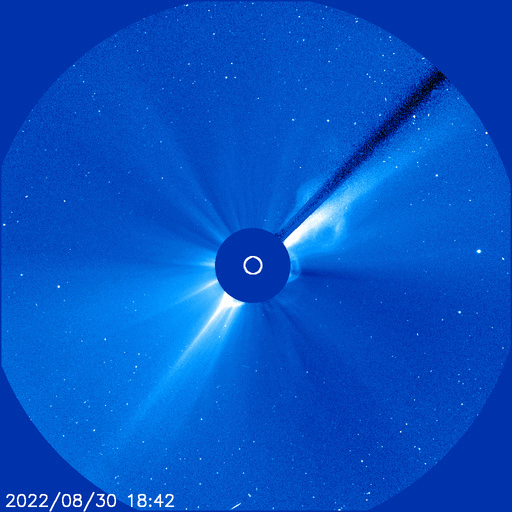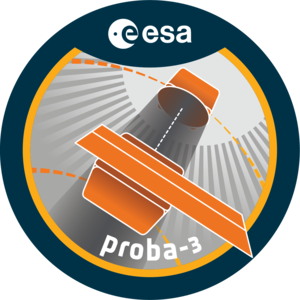Eclipse-maker: How Proba-3 subtracts the Sun
Hidden in plain sight within the Sun’s glare is the ultra-hot yet ghostly faint solar corona, source of the solar wind and solar storms. The only way to see this key element of the Solar System is either through the remarkable cosmic coincidence that gives rise to total solar eclipses – the fact that the Sun is not only 400 times bigger than our Moon but also about 400 times further away, allowing it to cover the solar disc entirely – or else artificially, through Sun-obscuring telescopes.
The biggest and most ambitious of these ‘coronagraphs’ is about to become reality: ESA's Proba-3 mission involves two spacecraft forming one giant virtual instrument, with one spacecraft covering the Sun for the other. But how does it work in practice?

The crown of light that surrounds the eclipsed Sun has been studied for centuries, but astronomers thought the corona might actually originate from the Moon or Earth’s atmosphere. Finally, it was ascertained that the corona was in fact the solar atmosphere, normally remaining unseen except during eclipses because it is a million times fainter than the fiery face of the Sun.
In 1931 French astronomer Bernard Lyot – based high in the Pyrenees to observe above the bulk of Earth’s atmosphere – completed the first ‘coronagraph’: a telescope incorporating a disc to occult the Sun, allowing sustained study of the corona.

Driving back waves of light
“This might sound simple, but it’s rendered much harder by the peculiar fact that light acts as both particles and waves,” explains Damien Galano, ESA’s Proba-3 mission manager. “This means some light spills around the edge of whatever’s blocking it, like waves around a seawall. This phenomenon is known as ‘diffraction’; it needs to be designed against to minimise unwanted sunlight reaching your instrument.”
The best way around diffraction is to move an occulting disc further from its telescope. “This is why total solar eclipses give us such an excellent view of the corona, because the Moon is around 384 000 km away from Earth, so diffraction effects are minimal,” explains Andrei Zhukov, Principal Investigator of Proba-3’s main instrument, Association of Spacecraft for Polarimetric and Imaging Investigation of the Corona of the Sun, ASPIICS.

Enter formation flying
“Astronomers can’t outdo natural eclipses, but ‘external coronagraphs’ in both Earth and space do place the occulter as far from the telescope as possible. In space our practical options have been limited however; for instance, the LASCO-C2 coronagraph aboard the ESA-NASA SOHO solar observatory has its occulter just 70 cm away, within the spacecraft body.”
So what about flying the occulter on a separate spacecraft altogether, as far away as possible? Researcher Philippe Lamy led the Laboratoire d'Astrophysique de Marseille team which first devised the ASPIICS concept: “By moving them much further apart we’d be able to see much closer to the edge of the solar disc, so formation flying seemed a natural fit. It wasn’t an entirely new idea, because the US and Soviet Union had attempted it during the 1975 Apollo-Soyuz mission, when a cylindrical Apollo spacecraft blocked out the Sun for the watching Soyuz spacecraft – but the bright glare produced by propellant thrusting from the spacecraft spoiled the view.”

ASPIICS was first designed by the Laboratoire d'Astrophysique de Marseille team about two decades ago, following a formation flying call for ideas from French space agency CNES, then found a home within ESA’s technology-demonstrating Proba satellite series.
Rapid rate of observations
“Today we have two ways of observing the corona from space,” notes Andrei Zhukov. “Extreme ultraviolet imagers aboard space missions such as NASA’s SDO and ESA’s Proba-2 observe Sun in a small field of view around it whereas externally-occulted coronagraphs observing in white light show the outer part of the corona only. That leaves a gap in observation that Proba-3 will fill, for six hours at a time.”

In addition, Proba-3 will observe at a much more rapid rate than previous space-based coronagraphs. SOHO’s LASCO-C2 usually updates its view only once every 12 minutes, while Proba-3 will have a 1-minute standard cadence, upgradable to a maximum 30 seconds, to yield fine details of the evolution of the massive explosions called Coronal Mass Ejections. “When I first heard about it, Proba-3 seemed like science fiction technology,” adds Andrei Zhukov. “But the real-life design will truly deliver excellent science.”
“There was a lot of discussions on the design,” recalls mission scientist Joe Zender. “It became a compromise between what in theory the technology can provide and what we can practically achieve in space.” Early trade-off calculations came up with a 150-m operating distance for the Coronagraph and Occulter spacecraft – attempting to balance optical performance with workable tracking efficiency and propellant budgets – and the need to fix their relative positions to just a few millimetres of precision.

Double disc design
Practical experimentation also played a role, including an ESA StarTiger R&D programme performed in 2009 by a team of European engineers that worked altogether at Laboratoire d'Astrophysique de Marseille for six months.
StarTiger concentrated on developing and testing the most critical subsystems of the instrument, including the “Shadow Position Sensors” and “Occulter Position Sensors” providing absolute references for the alignment and pointing of the two spacecraft, and the occulting disc. The project also yielded valuable findings on the best ways to engineer the edge of the occulting disc to minimise spillover light.

This 1.4 m diameter occulting disc to be flown on the Occulter spacecraft provided a crucial design element. It was produced by Airbus in Spain in carbon fibre reinforced plastic – a composite material whose strength and rigidity sees it employed for everything from wind turbine blades to Formula 1 cars and spacecraft hulls – based on a mould from Euro-Composites in Luxembourg.
“And in fact Proba-3 has a second much smaller but equally important and precisely manufactured occulting disc, placed within its central lens, just 3.5mm in diameter,” adds Damien Galano. “The 19th century experiments that established light as a wave showed that straylight spilling over a disc would constructively interfere in such a way that it is concentrated at the centre of the resulting shadow. This disc blocks much of those spillover wavelets; once that was ready we could really start testing out the rest of ASPIICS too.”

150-m long virtual instrument
As a result, while the alignment of lenses and occulters in a standard externally occulter coronagraph results in a coronal field of view that starts at around 2.5 times the extent of the Sun’s disc, for Proba-3 that figure is just 1.1 solar radii.
The flight model of the instrument built by Centre Spatial de Liège, CSL, is being hosted on Proba-3’s Coronagraph spacecraft, although the Occulter spacecraft forms an integral part of the instrument too – effectively the pair form a virtual 150-m long instrument.


Access the video
Joe Zender comments: “Success will rely on the formation flying technology working as planned, of course, but the closer we get to launch, the more I realise the excitement of what we are doing, including co-observations with many other solar observing missions.”
Andrei Zhukov adds: “After our approximately four-month commissioning stage the plan is to have two six-hour observing periods per week, determined by the mission’s need to conserve propellant. Instead of glimpsing the inner corona for just a few minutes during occasional terrestrial solar eclipses we’ll be keeping watch over sets of six-hour eclipses on demand, with a really good view of all the processes taking place, notably the eruption of CMEs and the acceleration of the solar wind.”














 Germany
Germany
 Austria
Austria
 Belgium
Belgium
 Denmark
Denmark
 Spain
Spain
 Estonia
Estonia
 Finland
Finland
 France
France
 Greece
Greece
 Hungary
Hungary
 Ireland
Ireland
 Italy
Italy
 Luxembourg
Luxembourg
 Norway
Norway
 The Netherlands
The Netherlands
 Poland
Poland
 Portugal
Portugal
 Czechia
Czechia
 Romania
Romania
 United Kingdom
United Kingdom
 Slovenia
Slovenia
 Sweden
Sweden
 Switzerland
Switzerland































